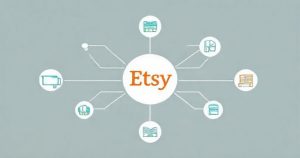In the dynamic world of online selling, particularly on platforms like Etsy, efficiency and automation are paramount for sustainable growth. Etsy integrations serve as powerful tools, connecting your Etsy shop with various external applications and services. These integrations are designed to streamline operations, reduce manual effort, and enhance overall business management, allowing sellers to focus more on creation and less on administrative tasks. Understanding and implementing the right Etsy integrations can significantly elevate a seller’s productivity and profitability, transforming a hobby into a thriving enterprise.
Understanding Etsy Integrations for Sellers
Etsy integrations refer to the process of linking your Etsy store with third-party software applications. These applications can manage a wide array of business functions, from inventory tracking and order fulfillment to accounting and customer relationship management. The primary goal of an Etsy integration is to create a seamless flow of data between your shop and other systems, eliminating the need for manual data entry and reducing the likelihood of errors. This interconnected ecosystem empowers sellers to manage their operations more effectively across multiple platforms or specialized tools.
Key Benefits of Integrating Etsy with Other Platforms
Implementing Etsy integrations offers a multitude of advantages that can significantly impact a seller’s business trajectory. These benefits extend beyond simple automation, fostering a more robust and responsive operational framework. From managing stock levels to enhancing customer interactions, integrations are pivotal for scaling an Etsy venture successfully in a competitive marketplace.
Automated Inventory Management
Maintaining accurate inventory levels across all sales channels is crucial to prevent overselling or stockouts. Etsy integrations for inventory management automatically update stock counts in real-time as sales occur on Etsy or other connected platforms. This synchronization ensures that your customers always see correct availability, improving satisfaction and reducing administrative burdens. Sellers of handmade items, vintage goods, or craft supplies benefit immensely from precise inventory control.
Streamlined Order Processing and Shipping
Efficient order processing and shipping are vital for positive customer experiences. Integrating Etsy with shipping software allows for the automated creation of shipping labels, tracking number generation, and instant customer notifications. This automation drastically cuts down the time spent on manual shipping tasks, enabling faster dispatch times and more organized fulfillment workflows. It also helps in comparing shipping rates to find the most cost-effective solutions for various product types.
Simplified Accounting and Bookkeeping
Managing finances can be complex for any business, especially for small business owners on Etsy. Accounting Etsy integrations connect your sales data directly to bookkeeping software, categorizing transactions and automating financial reports. This simplifies tax preparation, provides clear insights into profitability, and helps in forecasting future financial performance. Accurate financial records are indispensable for strategic business decisions and compliance.
Enhanced Customer Relationship Management (CRM)
Building strong customer relationships is fundamental for repeat business and positive reviews. While direct Etsy CRM integrations are less common, connecting Etsy sales data to general CRM tools can help track customer purchase history, preferences, and communication. This allows for personalized outreach, targeted marketing efforts, and improved overall customer service, fostering loyalty and community around your brand.
Expanded Sales Channels
Many sellers wish to expand beyond Etsy to reach a broader audience. Integrating Etsy with other e-commerce platforms like Shopify or WooCommerce allows for seamless product listing synchronization and order management across multiple storefronts. This capability enables sellers to diversify their sales channels without duplicating effort, effectively managing inventory and orders from a centralized system. It is a strategic move for maximizing market reach.
Print-on-Demand (POD) and Dropshipping Integrations
For sellers utilizing print-on-demand or dropshipping models, specialized Etsy integrations are indispensable. These tools automatically send new orders directly to your chosen fulfillment partner, who then prints or packs the item and ships it to the customer. This hands-off approach eliminates the need for sellers to manage inventory or shipping themselves, making it an ideal solution for a wide range of product types, from apparel to home decor.
Popular Etsy Integration Categories and Tools
The market offers a diverse range of integration solutions, each catering to specific business needs. Understanding these categories and popular tools within them can help sellers identify the most suitable options for their Etsy shop. Exploring typical functionalities and price points provides a clearer picture of potential investments and returns.
Inventory & Order Management Solutions
Tools like Sellbrite, Multiorders, and Veeqo are popular choices for managing inventory and orders across multiple sales channels, including Etsy. These platforms typically offer features such as centralized inventory syncing, order routing, and product listing management. Monthly pricing can range from approximately $50 to $500+, depending on the number of listings and sales volume. For businesses selling unique handmade items or vintage finds, robust inventory management prevents overselling, safeguarding reputation and profitability.
Shipping & Fulfillment Integrations
ShipStation, Pirate Ship, and ShippingEasy are leading names in shipping integrations. They connect directly with Etsy to import orders, generate labels, and automate tracking updates. ShipStation offers comprehensive features for businesses of all sizes, with plans starting around $9 per month. Pirate Ship is known for its free service and competitive USPS/UPS rates, making it attractive for smaller sellers. These tools significantly reduce the time spent on manual shipping tasks, enhancing efficiency and customer satisfaction.
Accounting & Bookkeeping Software
Integrating Etsy with accounting software like QuickBooks Online, Xero, or FreshBooks simplifies financial management. These integrations automatically import Etsy sales data, fees, and expenses, streamlining tax preparation and providing real-time financial insights. Monthly subscriptions typically range from $15 to $70. This strategic integration is crucial for understanding profit margins, managing cash flow, and making informed financial decisions, which is vital for long-term business health.
Print-on-Demand (POD) & Dropshipping Platforms
Platforms such as Printful, Printify, and Gelato seamlessly integrate with Etsy, allowing sellers to offer custom-designed products without holding inventory. When an order is placed on Etsy, it automatically routes to the chosen POD provider for production and shipping. While these services don’t have a direct integration fee, sellers pay for the product and shipping costs, impacting their profit margins. Typical profit margins can range from 20% to 40% per item, depending on the product type and pricing strategy. This setup is ideal for artists and designers looking to expand their product offerings.
Etsy to E-commerce Platform Integrations
For sellers looking to expand their presence, integrating Etsy with a dedicated e-commerce platform like Shopify or WooCommerce is a common strategy. Tools like LitCommerce or native apps on Shopify connect Etsy products and orders to the new store, allowing for centralized management. Shopify plans start around $29 per month, while WooCommerce is a free plugin for WordPress, though it requires hosting costs. This expansion allows sellers to build their brand identity and gain more control over their sales environment.
Choosing the Right Etsy Integration Solution
Selecting the appropriate Etsy integration solution requires careful consideration of various factors specific to your business. It is essential to assess your current operational needs, future growth plans, and financial capabilities. Making an informed decision ensures that the chosen tools genuinely enhance your workflow and contribute positively to your bottom line, rather than adding complexity.
Considerations for Your Business
When evaluating integration tools, consider your business size, the volume of your listings, and your specific operational bottlenecks. A small seller might prioritize a free or low-cost shipping integration, while a growing business may require a comprehensive inventory management system. Evaluate the complexity of your product types and the level of automation you need. Budget constraints are also a significant factor; some advanced solutions come with higher monthly fees.
Importance of Scalability and Ease of Use
Choose solutions that can grow with your business. A scalable integration will accommodate increased sales volume and new product lines without requiring a complete system overhaul. Equally important is ease of use; the platform should have an intuitive interface and clear documentation to minimize the learning curve. A user-friendly system ensures that you and your team can efficiently utilize its features, maximizing its benefits without extensive training.
Reviewing User Feedback and Support Quality
Before committing to an integration, thoroughly research user reviews and testimonials. Pay attention to feedback regarding reliability, customer support responsiveness, and overall user satisfaction. A robust support system is invaluable when you encounter technical issues or need assistance with specific features. Opting for solutions with a proven track record of excellent customer service can save significant time and frustration in the long run.
Maximizing Profitability Through Effective Etsy Integrations
The ultimate goal of implementing Etsy integrations is to enhance the overall profitability and sustainability of your business. By strategically leveraging these tools, sellers can not only save time and reduce costs but also improve customer satisfaction and gain valuable insights into their operations. This holistic approach to business management fosters an environment conducive to continuous growth.
Effective Etsy integrations lead to reduced operational costs by minimizing manual labor and preventing costly errors such as overselling or mis-shipments. The time saved through automation can be redirected towards product development, marketing, or customer engagement, which are direct drivers of revenue. Preventing customer dissatisfaction through accurate inventory and timely shipping also helps maintain a positive seller reputation, encouraging repeat purchases and referrals.
Furthermore, consolidated data from integrated systems provides clearer insights into sales trends, popular products, and financial performance. This data-driven approach allows sellers to make more informed decisions about pricing, product offerings, and marketing strategies. By optimizing every aspect of the business through smart integrations, Etsy sellers can cultivate a highly efficient, profitable, and enjoyable entrepreneurial journey, unlocking their full e-commerce potential.





